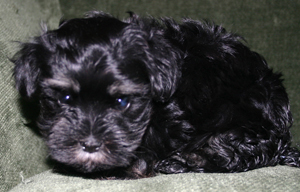Plans for breeding begin prior to your bitch coming into season. Because a stud dog may be reluctant to perform in unfamiliar surroundings, it is customary to take the female to the stud. In some cases, the female will remain in the stud owner’s care for several days as mating takes place. Other stud owners may prefer to schedule a one or two hour visit by the bitch and her owner for mating, with a return visit planned after a 48 hour interval. Ultimately, the timing is not up to the humans. There are cases where a bitch owner has traveled to the stud dog, only to spend two weeks in a hotel as unsuccessful breeding attempts are made. A bitch that is presumed to be in season is often shipped to a stud owner, sometimes weeks in advance of actual ovulation. It is important to have a clear understanding between the owner of the bitch and stud dog regarding the uncertainties and unanticipated circumstances of the planned breeding.
The female is considered ‘in heat’ when a vaginal discharge occurs. The discharge on day one is typically a bright red color that gradually lightens to a straw color around day nine. It is customary to conduct the first breeding when the discharge changes to a straw color, or around day seven to nine of the heat cycle. Breeding is then repeated 48 hours after the first mating to enhance the chances of fertilization taking place.
Ovulation may occur early or late in a particular bitch. Your veterinarian can run a series of tests to determine the exact date of ovulation. Shipping has been known to stress a bitch and prevent ovulation, so some veterinarians recommend that the bitch be shipped after she ovulates. Airline safety regulations have complicated the process of shipping dogs. Be sure to make arrangements for air travel and understand the requirements well in advance of your bitches anticipated heat cycle.
Estrus and Timing: Making Arrangements for Artificial Insemination
Advance planning and preparation is critical when the dam is to be impregnated via artificial insemination. The estrus cycle and optimal timing must be determined, arrangements must be made for the collection and transportation of semen, and physical insemination of the bitch must be scheduled.
Semen for artificial insemination is collected and made available in either a fresh or frozen state. The actual insemination is accomplished through vaginal deposit, trans-cervical (catheter) insemination, or surgical implant. Vaginal and trans-cervical inseminations are preferable as they do not entail the risk of general anesthesia and surgery.
Fresh semen collected at the time and on the same premises as the breeding will result in the most successful pregnancies. Of course this requires that the sire and dam be available in the same location. This may be recommended when attempts at natural breeding are unsuccessful for some reason.
Fresh semen and frozen semen is used when the sire and dam cannot be in the same location at the optimal time of breeding. Fresh semen and fresh-extended semen has a longevity of a few days, and often results in successful pregnancies. Frozen semen, once thawed, only lives for a period of two to twelve hours. Timing of insemination using frozen semen is critical. The use of frozen semen statistically has the lowest pregnancy success rate.
Stud Contracts
Normally, a stud contract will stipulate that the stud owner will ensure that the stud has been tested for Brucellosis prior to breeding. Often, the contract also requires that the dam be tested too, so make arrangements with you vet before taking her to the stud.
Make sure you read and understand the contract for stud service prior to the onset of heat in your bitch. Payment arrangements should be clear.
Be sure you understand the consequences if your bitch does not conceive, if puppies do not survive, or if only one puppy is produced from a litter. Often a repeat breeding is provided by the stud owner at no additional charge under these circumstances. If your bitch is being cared for by the stud dog owner, make sure the contract stipulates that she will not be exposed to any intact dogs other than the selected stud, and that breeding will not take place without supervision.
Placement of Puppies

The time to consider permanent homes for your litter is before the breeding takes place. A good breeder will be responsible for their puppies for life. You may have articulated your objectives for breeding, as suggested previously in this guide. Perhaps you are breeding a show dog for yourself, or have a contractual obligation to breed back to a specific dog. Consider what you will require of the future owners of your litter. Will the pups be spayed/neutered? Must they be health-tested in order to be used for future breeding? You should write your puppy contract and provide a blank contract to prospective buyers for their review. Be sure you understand your puppy buyers expectations, and be sure they understand yours.
Puppy Application and Breeder Questionnaire
A puppy application is an excellent tool to communicate your expectations to future buyers. Often a breeder will require a completed application prior to allowing a buyer to place a deposit on a future puppy. Conversely, a puppy buyer may present you with a breeder questionnaire, in order to ascertain the circumstances of their future puppy’s existence. Sample questionnaires can be found on many breeder websites
Taken from Canine Reproduction – The Breeder’s Guide, 2nd Edition by Phyllis A. Holst, MS, DVM. Adapted By Janet Hicks and Carol Croop
